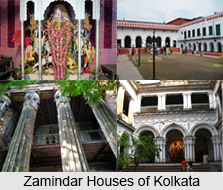 Bonedi Houses of Kolkata are now in dilapidated condition, but once these houses were flourished with the Hindu architecture, Mughal architecture and the British architecture in the midst of Chinese and Britain furniture and porcelain figures and different types of antiques items.
Bonedi Houses of Kolkata are now in dilapidated condition, but once these houses were flourished with the Hindu architecture, Mughal architecture and the British architecture in the midst of Chinese and Britain furniture and porcelain figures and different types of antiques items.
The traditional household pujas of Kolkata, West Bengal are also known as “Bonedi Barir Pujo†The word Bonedi barir pujo in Bengali language. These traditional houses have actually preserved the culture and tradition from the British era. During Durga pujas these aristocratic houses allow local and foreign tourists to take part in the puja celebrations. Some of the aristocratic familes in Kolkata are Shobhabazar Rajbari, Rajkrishna Deb`s Thakurdalan, Khelat Ghosh"s House, House of Sabarna Roy Choudhury, Narasingha Daw (Dawn) bari, Hatkhola Duttabari, Mitrabari of Darjipara, Basumallick Bari of Potoldanga, Lahabari and many more.
Nabkrishna Deb`s Rajbari
Nabakrishna Deb who was considered as the Raja of Kolkata in the early phase of 18th century, was a zamindar of Kolkata. It was during his time and his palace in Shobhabazar was the foremost house of Mughal and British architecture. During Durga Puja, the Shovabazar Palace is the main cynosure of North Kolkata Bonedi barir pujo.
Khelat Ghosh"s House
The house of Khelat Ghosh is celebrating Durga Puja for more than 180 years. This house has the mixture of Muslim and Vaishnava architecture and the sculpture placed in the different parts of house attracts the tourists and showed the splendid elegance in business of early era.
Palace of Sabarna Roy Choudhury
They are known as the early jagir of Kalikata, Gobindapur and Sutanuti, now placed near Barisha and Sarshuna region of South Kolkata. They are known as the premier families of Kolkata in early times, now scattered in eight branches in families.
Narasingha Daw Palace
Loacted in the Northern part of Kolkata and a cultural fringe of Kolkata- Jorasanko, famed after the birth of Tagore family of Bengal, who were the early proficient business men in Bengal. Daw family was also in the list of trader"s family.
Hatkhola Duttabari
Located in the northern fringe of Kolkata, Hatkhola Duttabari gives one the detailed architectural splendour of British, Greek and Hindu suzerainty. Its address was 78, Neemtala Ghat Street.
Chhatu Babu Latu Babu Bari
Located in Ramdulal Nibas (Thakurbati) off Beadon Street of Kolkata, very near to Girish Park Metro Station, this house gives the sculptural detailing of that era and now this house is preserved for heritage events of Kolkata.
Other houses of Kolkata are Lahabari, Basumallick Bari of Potoldanga, Mitrabari of Darjipara, Durga Charan Mitra`s Thakurdalan, Gosain Bari, KolooKolootala`s Badan Chandra Roy Bari, and Behala`s Roy Bari.
Related Articles
Culture of Kolkata
Kolkata
History of Kolkata
Monuments in Kolkata
Tourism In Kolkata
Kolkata Town Hall
Birla Planetarium
Modern History of Kolkata
Modern History of Royal Calcutta Turf Club
Medieval History of Kolkata
Medieval History of Bengal
British Empire in India
Impact of British Rule in India
History of British Architecture in India
British Indian Acts
British Military Architecture in India
British East India Company
Indian English literature During British India
West Bengal, Indian State
Tribes of West Bengal
Culture of West Bengal
Bankura District
Role of Zamindars in Bengal under Mughals
Permanent Settlement Act of 1793
British Land Revenue System in India
Revolts against Mughal Empire
Palaces of West Bengal
Monuments of West Bengal
Monuments in Murshidabad
Monuments in Barrackpur
Marble Palace, Kolkata
Shobhabazar, Kolkata, West Bengal
Bowbazar, Kolkata, West Bengal
Rituals of Durga Puja
Mahalaya, Festivals of West Bengal
Durga Puja
Bodhon, Rituals of Durga Puja
Goddess Durga
Maha Sashti, Sixth Day of Durga Puja
Kali Puja
Durga Temples in India



















